Let’s Talk About Elden Ring a Bit
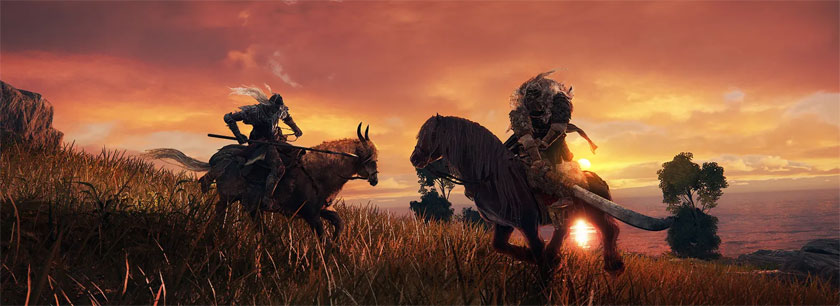
It’s been a month since Elden Ring released, which is about enough time for the honeymoon phase to be over. Theoretically, at least. Crawling through the Elden Ring sub-reddit, it’s easy to find a number of still-obsessed players turning their experiences into memes to share, discussing the New Game+ experience, and even new players to the “genre” expressing their love for the game. There has been no shortage of controversy, what with the poor PC performance at launch leading to review bombs on the Steam platform, only to turn around and be critized by developers of Ubisoft and Guerilla Games in a rather unprofessional manner. The ensuing discussion could have led to the possibility of Horizon fans review bombing Elden Ring with dishonest intentions.
Of course, nothing has stopped the game from selling over twelve-million copies worldwide. Elden Ring was lauded by many websites, publications, and communities as the most highly anticipated game coming in 2022, but rarely do the niche opinions of an enthusiast audience cross over into the mainstream in this manner. While we cannot calculate the number of players trading the game back to GameStop after just a few hours of struggle, we can occasionally see a first-timer post in the aforementioned sub-reddit a joyful celebration of taking down their first few bosses or, at times, the entire game.
It may seem odd to say, but the aggregate praise, the sales numbers, or the nit-picking complaints of a handful of disgruntled developers and journalists don’t mean anything to the actual quality of the game. Is it a “masterpiece” as many have lauded it as? Well, obviously not, but… yes, actually. It’s a complicated issue, as Elden Ring is the culmination of over a decade of refining a flawed game-type, or style, in a flawed engine, by a flawed development team. Comments regarding the inability to adjust text-size in the UI as regards to accessibility are legitimate, and is an issue the studio should have sorted out years ago. That this game cannot hit a stable 60fps on the most up-to-date console hardware and has myriad performance issues on PC is inexcusable. It still baffles me that I cannot compare my current gear’s stats to that which is available in the shops. None of these issues have anything to do with the silly “difficulty argument” and therefore would not change the core of the experience, save for improving it. It is, without a doubt, an imperfect game.
At the same time, I am nearly one-hundred hours into Elden Ring, have crawled through every cavern and crevice I’ve been able to find thus far, and not only still have several more hours of content ahead of me, but have continued to miss little paths, quests, or details throughout my adventure. I’ve continued to be surprised and gasp at various revelations and discoveries. Unlike Breath of the Wild, where I stopped around some seventy-to-ninety hours due to feeling as if I’d seen enough and was ready to be done, I am continuing to plumb the depths of Elden Ring because there is so much to see.
It’s kind of difficult not to perceive such a game as being a masterpiece when that is your experience with it. Nonetheless, I certainly am inching ever closer to that feeling of being absolutely done with Elden Ring... for now, at least.
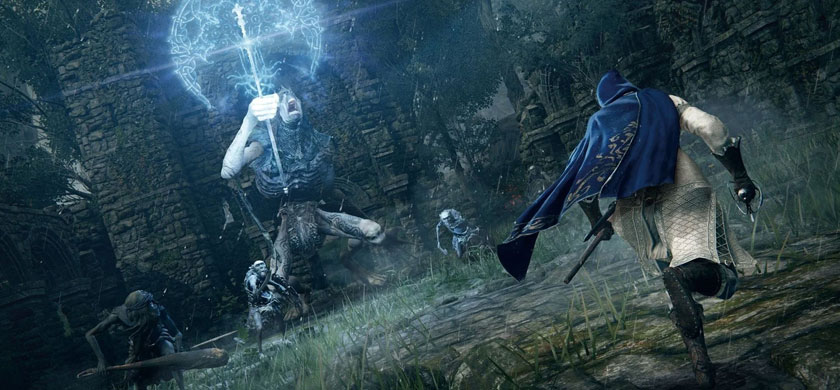
Despite having unlocked the ability to respec my character since the… thirty or forty hour mark? I have largely stuck with my melee-focused build throughout the entire game. I have not experimented much with the magic as I’m too much of a numbskull to trust in spells over raw muscle power. Despite lacking any trait that would contribute to being an excellent fighter in real life, I have always been drawn to swift-striking melee classes throughout my video and tabletop gaming life. Nonetheless, I’ve continued to ponder what it might be like to start a new save file as a Confessor or Prisoner, whose base-stats and starting equipment allow for some melee adequacy but emphasize the power of sorcery and incantations. It is very rare that I’ve spent so much time on a game and thought of how I could go back and do things differently. Yet Elden Ring is a game that players will be returning to – and already are – over and over again. Be it for the increasing difficulty of From Software’s New Game Plus or going back in right from the start, many players are testing out speed-run tactics and low-level builds in order to further challenge themselves. There’s a lot of customization and mechanical depth here, and players of all kinds have much to sink their teeth into.
More than that, however, is just the variety of zones and dungeons there are. I was originally dismayed to recognize chambers and assets being recycled across the various catacombs, caverns, and mines, as each repeated room or elevator shaft would break the illusion and paint a picture of the level editing software in my mind. I could see the designers grabbing a pre-built room for a catacomb, flipping it, and clicking where to place the impish gargoyles so that they might gleefully pounce the player from behind or the side.
Yet the further I progressed, the less frequently I found myself in such environments, and the more often I found myself exploring a wholly new and unique labyrinthine location. Be it castle, city, fortress, or manor, there are so few recycled assets in this game that… well, it makes those few that are stand out all the more. Unlike Breath of the Wild’s minimalistic, near-featureless Shrines being the primary location for puzzle-solving that drives much of the game’s exploration, these catacombs, caverns, and caves perhaps make up the least amount of locations and time that the player will find themselves exploring.
Perhaps more noticeable are the number of recycled opponents used as bosses. However, even these are spread out enough so as not to become tiresome. Some difficult bosses become standard enemies, some standard enemies are powered up to become bosses, and many repeated foes are given additional powers, status effects, and move-sets in order to provide a remixed challenge. There is also something to be said about the manner in which these foes appear, often coming as a surprise and sometimes when you’d least expect. The typical response is more likely to be a startled “oh crap!” and rush to either flee or prepare one’s buffs and summons than it is a tiresome groan.
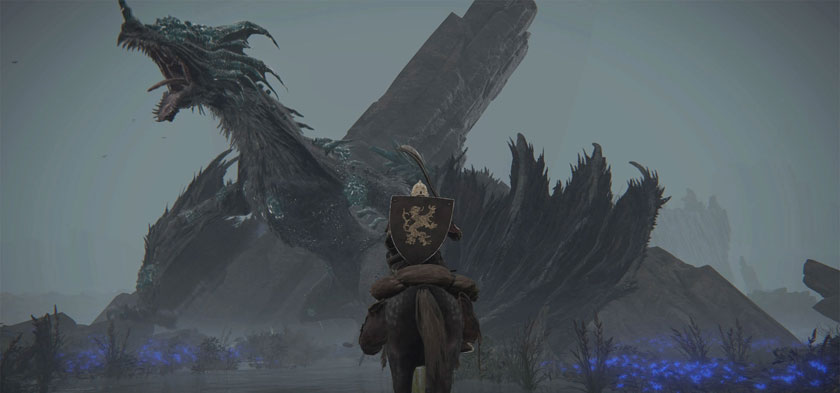
Note that I bring up all of this repeated content not to disparage the game. Open-worlds are effectively built off of repeated and easily remixed content in order to provide as much gameplay as possible for players to see and experience. What makes Elden Ring so impressive is not only how little repeat content there is, but how much what repeat content is there is modified and remixed. No two catacombs or caverns are completely alike. Naturally this is somewhat less accurate for bosses and beasts, as they’ll largely rely on higher levels and stats to continue providing a challenge. Nonetheless, it’s not uncommon to face a familiar opponent only to suddenly find yourself fleeing an unexpected cloud of the scarlet rot status effect, or to find yourself evading your new nemesis in a lake of poison or beside a lake of magma. Sometimes these fights will be in claustrophobic chambers, and others they’ll be on horseback in the open-world.
Nevertheless, I have continuously found dozens of enemies and environments throughout the game that are all uniquely crafted together and coded. It was perhaps some twenty hours in that I realized the wolves themselves must have been granted new artificial intelligence in order to run about the open-world, leaping up to and down from boulders, rocks and ruins that dotted the plains they called home, and flanking the player as a pack for the taking. They did not behave like many of the domesticated rabid dogs of the world, who themselves behave little differently from the foul curs that wandered the streams of Yharnam in Bloodborne. For all of the recognizable animations taken from prior Souls games, there’s still so much new content in Elden Ring that continually surpasses my expectations.
As reductionist as it is to claim that Elden Ring is just Dark Souls in an open-world, it is not wholly inaccurate. Unlike other open-worlds, Elden Ring’s mechanics are built upon a decade of refinement. The pacing of your attacks and the rolling of your dodges are all very similar to the other From Software developed games in this “genre”, which begs the question of whether it’s the genre that fans love. Many games have replicated the loss of experience and/or currency upon death, the bonfires, the respawning enemies, the fatigue bar, and other superficial elements that act as recognizable icons of the Soulsborne. However, is there not also an appeal to the brutal manner in which weapons strike through opponents, the audibly wet splash of blood soaking the player’s senses in imagined viscera? Is it not found in the clanking of one’s armor as they try to sprint away at a pace more comparable to a morning jog? Is it not the pounding chime confirming the success of a lethal backstab? The mood setting drone as the player respawns in any zone, reminding them there is no such thing as a truly safe haven?
Though Bloodborne deviated from some of the base mechanics of the Dark Souls franchise, it was, in its heart, still very similar in technology, presentation, and pacing to the other games. They are similar in a fashion that other developers would be – and have been – called lazy for. So why is it that Ubisoft has been criticized for the legacy of games such as Assassin’s Creed and Far Cry, or Activision for its constant churn of Call of Duty titles, when From Software gets such a pass?
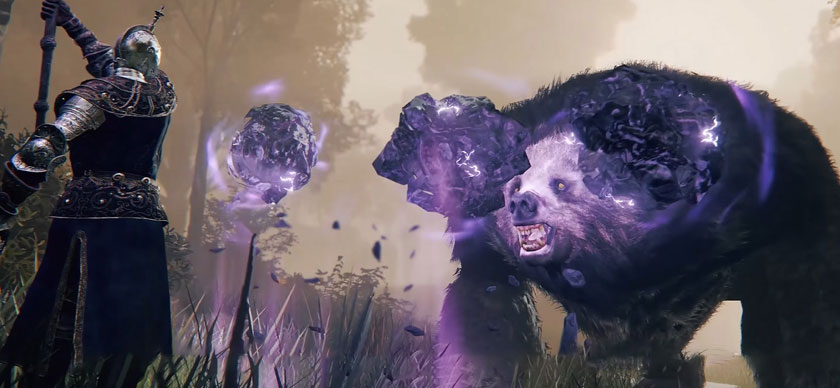
There is no simple answer, though we can at least begin with the core mechanics that embody Dark Souls and now Elden Ring being solid. Much like players can continue playing Destiny 2 on a weekly basis for satisfying first-person combat with few peers, there aren’t many games with challenging-yet-accessible combat systems like From Software’s action-RPG line-up. Yes, I did say accessible, though not in terms of features designed with disabled players in mind. I mean that From Software’s games, even Bloodborne, are slower-paced than franchises like Bayonetta or Devil May Cry, and also do not rely on mastery of combos or movesets in order to succeed. Though Bloodborne is filled with fancy combination attacks utilizing the trick weapon transformation abilities, I primarily kept hacking away at enemies without adjusting the state of the trick weapon because… it worked. I’ve encountered many that refer to a game like Devil May Cry as a “button-masher” when, in truth, I’ve mashed more buttons in From’s games than I ever had in one of Capcom or Platinum’s brawlers. No, you cannot just keep hacking away carelessly at a foe in any From title, but I don’t know of any action game worth its salt where you can.
Nevertheless, even if it’s just a handful of swings, you can button mash your way through a From Software game so long as you can also avoid taking damage. This means the combat is based around very simple concepts of dodging, blocking, and striking. Are there also deeper considerations such as poise or status resistances? Of course, but once again, knowledge of and adherence to these things are not necessary. However, they do make the game easier, and still do not require the quick-thinking response of combos like a Devil May Cry or Bayonetta. It’s the RPG mechanics that both provide depth while simultaneously being accessible enough for less experienced or enthusiast players to grasp onto.
It is in this spirit that From Software has only increased player options without also increasing complexity in Elden Ring. Magic is used no differently than a standard weapon, yet is also more powerful than prior From Software games. It does, however, require a sacrifice in the strength of other attributes. Players can now summon Spirit Ashes, allowing for additional cohorts to appear on-screen to deal minor damage and draw enemy aggression without also doubling or tripling a boss’ health in the manner that co-op summons will. The speed of the player’s horse, Torrent, means some over-world foes and bosses are far easier to avoid and dispatch than if they were on foot; of course, the same is true for the reverse, where some larger foes are actually easier to dodge and avoid while on foot. None of these mechanics are overly complex, yet they continue to add depth and customization to the player’s experience.
Which, I think, brings us to why Elden Ring isn’t just an open-world Dark Souls. Leading up to the game’s release, director Miyazaki was frequently discussing how little mechanics were added in order to increase the amount of time the player spent in the game’s world. Slaying a group of foes would reward the player with replenished health or magic flasks, for example. The ability to craft was added so that the player didn’t have to purchase new ammunition or explosives, a decision that not only gives more purpose to the space in the open-world and exploring it by scattering materials throughout its terrain, but also encourages the player to more freely use the bone knives, arrows, and bombs in their possession. The horse and ability to jump were also included in order to improve the rate at which the player could explore the sprawling open-world.
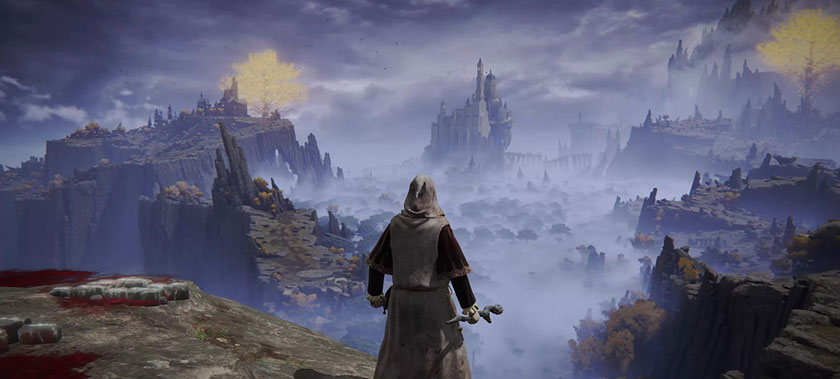
I highlight these adjustments because it goes to show that the development team weren’t thinking as simply as “Dark Souls, but open-world”. Instead, they knew they would be bringing their current, base-level design forward into an open-world, but also considered the limitations of their current design in this new context. Thus, abilities to prolong a player’s time wandering and exploring were increased, additional methods of respawning were added, and certain enemies and their A.I. were designed or updated to work and behave in a far larger and more open environment.
So, yes, Elden Ring still feels like a Souls game at its core, but it has also expanded into a playstyle informed by this far larger environment the player is now able to explore. Crafting materials are always worth snagging since they’re used for so many different recipes, and every cavern and catacomb is home to some form of reward, even if it’s merely in the runes that can help you reach that next level up.
That world acts as both a method to keep the player invested in the gameplay while also creating a reason to explore further and further. Limgrave is the peaceful, beautiful landscape you’d expect an open-world to contain, but the player is swiftly roaming through foggy swamps, drowned academies, Hellish landscapes corrupted by the crimson blood-colored rot, and plunging into starlight stricken depths of impossibility. Each of these areas will introduce the player to new foes, new treasures, new bits of lore if they pay enough attention, and even unique combat encounters crafted exclusively for that environment. There are mysteries to be uncovered and puzzles to be sorted out.
I suppose what I’ve done here is illustrate why someone might feel underwhelmed by Elden Ring. I have made note that the game is not only based on decade-long mechanics, but also utilizes familiar reusage of assets just as any other open-world game. However, to only look at those items is a disservice to the harder to grasp achievement that goes into this massive, uniquely crafted world. As I mentioned earlier in this essay, by this point in time I had finished playing Breath of the Wild because I felt as if I had seen all of it had to offer that mattered. With Elden Ring, I continue to explore and squeeze out every droplet of content I can find because I feel as if there’s still more being kept hidden from me.

To that extent, Elden Ring truly is a masterpiece. It is imperfect, but it also feels as if it is a game that should not exist; a game that the industry has convinced us cannot exist. Yet here it is before us, after so many years of development. Even if it is not perfect, it is a type of game perfected, and that is not a feat to dismiss carelessly.
It also acts as a beacon of hope to the most skeptical of players. There are no loot boxes, there are no invasive microtransactions, there are no appeals to the mainstream here. Yet the game has managed to obtain mainstream success nonetheless. While it only happens every so often, it is reassuring to know that a game that treats its players with enough respect to anticipate and request they learn, improve, and explore can appeal to so many.
Which means it’s time for the most hardcore of the fans to finally stop evangelizing. If Elden Ring can accomplish that, then it truly is a masterpiece.


